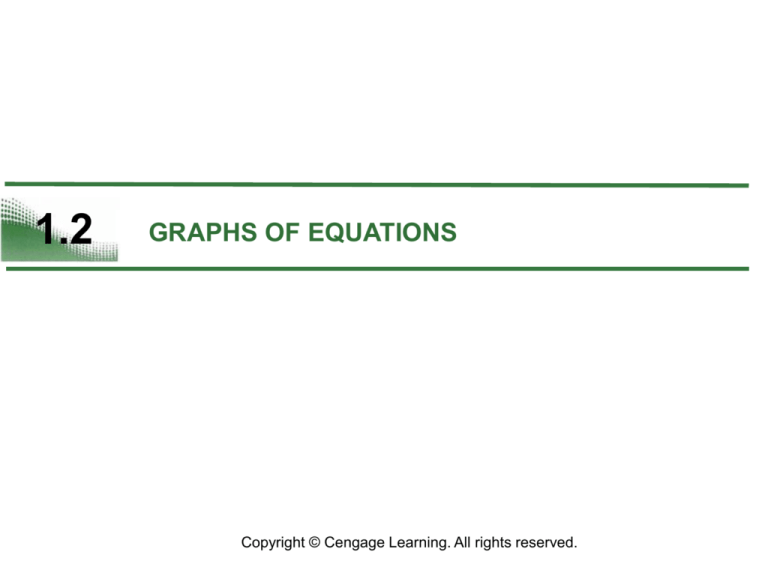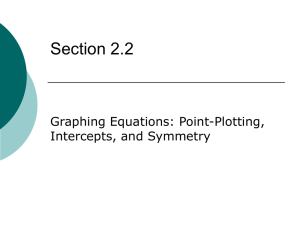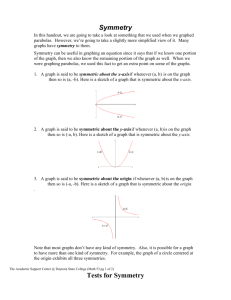
1.2
GRAPHS OF EQUATIONS
Copyright © Cengage Learning. All rights reserved.
What You Should Learn
• Sketch graphs of equations.
• Find x- and y-intercepts of graphs of equations.
• Use symmetry to sketch graphs of equations.
• Find equations of and sketch graphs of circles.
• Use graphs of equations in solving real-life
problems.
2
The Graph of an Equation
3
The Graph of an Equation
We have used a coordinate system to represent graphically
the relationship between two quantities.
There, the graphical picture consisted of a collection of
points in a coordinate plane.
Frequently, a relationship between two quantities is
expressed as an equation in two variables.
For instance, y = 7 – 3x is an equation in x and y. An
ordered pair (a, b) is a solution or solution point of an
equation in x and y if the equation is true when a is
substituted for x and b is substituted for y.
4
The Graph of an Equation
For instance, (1, 4) is a solution of y = 7 – 3x because
4 = 7 – 3(1) is a true statement.
In this section you will review some basic procedures for
sketching the graph of an equation in two variables.
The graph of an equation is the set of all points that are
solutions of the equation.
5
The Graph of an Equation
The basic technique used for sketching the graph of an
equation is the point-plotting method.
6
Example 2 – Sketching the Graph of an Equation
Sketch the graph of y = 7 – 3x.
Solution:
Because the equation is already solved for y, construct a
table of values that consists of several solution points of the
equation.
For instance, when x = –1,
y = 7 – 3(–1)
= 10
which implies that (–1, 10) is a solution point of the graph.
7
Example 2 – Solution
cont’d
From the table, it follows that
(–1, 10), (0, 7), (1, 4), (2, 1), (3, –2), and (4, –5)
are solution points of the equation.
8
Example 2 – Solution
cont’d
After plotting these points, you can see that they appear to
lie on a line, as shown in Figure 1.14.
Figure 1.14
The graph of the equation is the line that passes through
the six plotted points.
9
Intercepts of a Graph
10
Intercepts of a Graph
It is often easy to determine the solution points that have
zero as either the x–coordinate or the y–coordinate.
These points are called intercepts because they are the
points at which the graph intersects or touches the
x- or y-axis.
11
Intercepts of a Graph
It is possible for a graph to have no intercepts, one
intercept, or several intercepts, as shown in Figure 1.18.
No x-intercepts;
one y-intercept
Three x-intercepts;
one y-intercept
One x-intercept;
two y-intercepts
No intercepts
Figure 1.18
Note that an x-intercept can be written as the ordered pair
(x, 0) and a y-intercept can be written as the ordered pair
(0, y).
12
Intercepts of a Graph
Some texts denote the x-intercept as the x-coordinate of
the point (a, 0) [and the y-intercept as the y-coordinate of
the point (0, b)] rather than the point itself.
Unless it is necessary to make a distinction, we will use the
term intercept to mean either the point or the coordinate.
13
Example 4 – Finding x- and y-Intercepts
Find the x- and y-intercepts of the graph of y = x3 – 4x.
Solution:
Let y = 0. Then
0 = x3 – 4x
= x(x2 – 4)
has solutions x = 0 and x = ±2.
x-intercepts: (0, 0), (2, 0), (–2, 0)
14
Example 4 – Solution
cont’d
Let x = 0. Then
y = (0)3 – 4(0)
has one solution, y = 0.
y-intercept: (0, 0)
See Figure 1.19.
Figure 1.19
15
Symmetry
16
Symmetry
Graphs of equations can have symmetry with respect to
one of the coordinate axes or with respect to the origin.
Symmetry with respect to the x-axis means that if the
Cartesian plane were folded along the x-axis, the portion of
the graph above the x-axis would coincide with the portion
below the x-axis.
17
Symmetry
Symmetry with respect to the y-axis or the origin can be
described in a similar manner, as shown in Figure 1.20.
x-axis symmetry
y-axis symmetry
Origin symmetry
Figure 1.20
Knowing the symmetry of a graph before attempting to
sketch it is helpful, because then you need only half as
many solution points to sketch the graph.
18
Symmetry
There are three basic types of symmetry, described as
follows.
19
Symmetry
You can conclude that the graph of y = x2 – 2 is symmetric
with respect to the y-axis because the point (–x, y) is also
on the graph of y = x2 – 2. (See the table below and
Figure 1.21.)
y-axis symmetry
Figure 1.21
20
Symmetry
21
Example 5 – Testing for Symmetry
Test y = 2x3 for symmetry with respect to both axes and the
origin.
Solution:
x-axis: y = 2x3
–y = 2x3
y-axis: y = 2x3
Write original equation.
Replace y with –y. Result is not an
equivalent equation.
Write original equation.
y = 2(–x)3
Replace x with –x.
y = –2x3
Simplify. Result is not an equivalent
equation.
22
Example 5 – Solution
Origin: y = 2x3
cont’d
Write original equation.
–y = 2(–x)3
Replace y with –y and x with –x.
–y = –2x3
Simplify.
y = 2x3
Equivalent equation
Of the three tests for symmetry,
the only one that is satisfied is
the test for origin symmetry
(see Figure 1.22).
Figure 1.22
23
Symmetry
Throughout this course, you will learn to recognize several
types of graphs from their equations.
For instance, you will learn to recognize that the graph of a
second degree equation of the form
y = ax2 + bx + c is a parabola.
The graph of a circle is also easy to recognize.
24
Circles
25
Circles
Consider the circle shown in Figure 1.25. A point (x, y) is
on the circle if and only if its distance
from the center (h, k) is r. By the
Distance Formula,
By squaring each side of this equation,
you obtain the standard form of the
equation of a circle.
Figure 1.25
26
Circles
From this result, you can see that the standard form of the
equation of a circle with its center at the origin,
(h, k) = (0, 0), is simply
x2 + y2 = r 2.
Circle with center at origin
27
Example 8 – Finding the Equation of a Circle
The point (3, 4) lies on a circle whose center is at (–1, 2),
as shown in Figure 1.26. Write the standard form of the
equation of this circle.
Figure 1.26
28
Example 8 – Solution
The radius of the circle is the distance between
(–1, 2) and (3, 4).
Distance Formula
Substitute for x, y, h, and k.
Simplify.
Simplify.
Radius
29
Example 8 – Solution
Using (h, k) = (–1, 2) and r =
cont’d
, the equation of the
circle is
(x – h)2 + (y – k)2 = r 2
[x – (–1)]2 + (y – 2)2 = (
(x + 1)2 + (y – 2)2 = 20.
Equation of circle
)2
Substitute for h, k, and r.
Standard form
30
Application
31
Application
In this course, you will learn that there are many ways to
approach a problem. Three common approaches are
illustrated in Example 9.
A Numerical Approach: Construct and use a table.
A Graphical Approach: Draw and use a graph.
An Algebraic Approach: Use the rules of algebra.
32
Example 9 – Recommended Weight
The median recommended weight y (in pounds) for men of
medium frame who are 25 to 59 years old can be
approximated by the mathematical model
y = 0.073x2 – 6.99x + 289.0, 62 x 76
where x is the man’s height (in inches).
(Source: Metropolitan Life Insurance Company)
a. Construct a table of values that shows the median
recommended weights for men with heights of 62, 64,
66, 68, 70, 72, 74, and 76 inches.
33
Example 9 – Recommended Weight
cont’d
b. Use the table of values to sketch a graph of the model.
Then use the graph to estimate graphically the median
recommended weight for a man whose height is
71 inches.
c. Use the model to confirm algebraically the estimate you
found in part (b).
34
Example 9(a) – Solution
You can use a calculator to complete the table, as
shown below.
35
Example 9(b) – Solution
cont’d
The table of values can be used to sketch the graph of
the equation, as shown in Figure 1.27. From the graph,
you can estimate that a height of 71 inches corresponds
to a weight of about 161 pounds.
Figure 1.27
36
Example 9(c) – Solution
cont’d
To confirm algebraically the estimate found in part (b),
you can substitute 71 for x in the model.
y = 0.073(71)2 – 6.99(71) + 289.0 160.70
So, the graphical estimate of 161 pounds is fairly good.
37










